23 Types Of BIRDS OF PREY In Illinois (ID Guide With Photos)
Did you recently come across a bird of prey in Illinois, and want to know what species it was?
Identifying raptors in the Prairie State is not as easy as it might seem, since there are many birds of prey that regularly occur in Illinois.
To help you identify the bird you saw, we’ll cover the most common birds of prey of Illinois in this article.
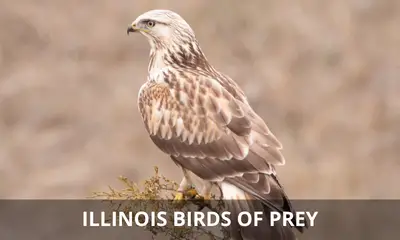
What are the types of birds of prey in Illinois?
The 23 types of birds of prey found in Illinois are:
- Red-tailed Hawk
- Sharp-shinned Hawk
- Cooper’s Hawk
- Northern Goshawk
- Rough-legged Hawk
- Red-shouldered Hawk
- Broad-winged Hawk
- Northern Harrier
- Bald Eagle
- Golden Eagle
- Osprey
- American Kestrel
- Peregrine Falcon
- Turkey Vulture
- Black Vulture
- Great Horned Owl
- Barn Owl
- Long-eared Owl
- Short-eared Owl
- Barred Owl
- Snowy Owl
- Eastern Screech-owl
- Northern Saw-whet Owl
Note that this list includes both diurnal birds of prey (hawks, eagles, falcons, harriers, and vultures), as well as nocturnal birds of prey (owls).
While many of these birds of prey are found all year in Illinois, a number of them only occur in the state only during the breeding season in summer.
Yet other raptor species are winter visitors to Illinois, and a few are vagrants that only rarely occur in the state.
Now let’s dive into the details, and take a closer look at each of these raptors in Illinois:
Hawks
Red-tailed Hawk
Scientific name: Buteo jamaicensis
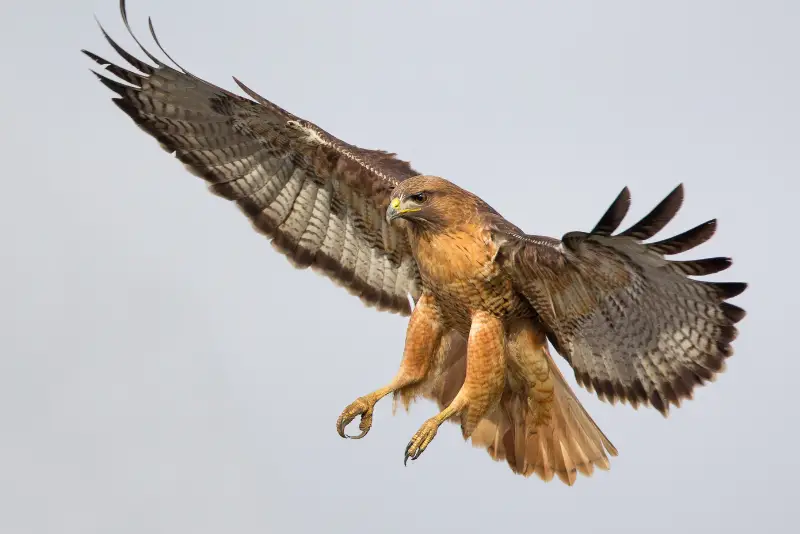
With a wingspan of up to 52 in (4.5 ft), the Red-tailed Hawk is one of the larger types of hawks in Illinois.
It has variable coloration, ranging from dark brown to almost entirely white, but can be readily recognized by its rusty red tail.
This large hawk is common in open grassland and also in cities. It is most often seen perched on roadside posts or fences, waiting for prey.
The Red-tailed Hawk is one of the most common hawk species in Illinois, and can be seen throughout the Prairie State year-round.
This bird of prey feeds on rodents and other small animals that it catches by swooping down from its perch when they venture out into the open.
Sharp-Shinned Hawk
Scientific name: Accipiter striatus
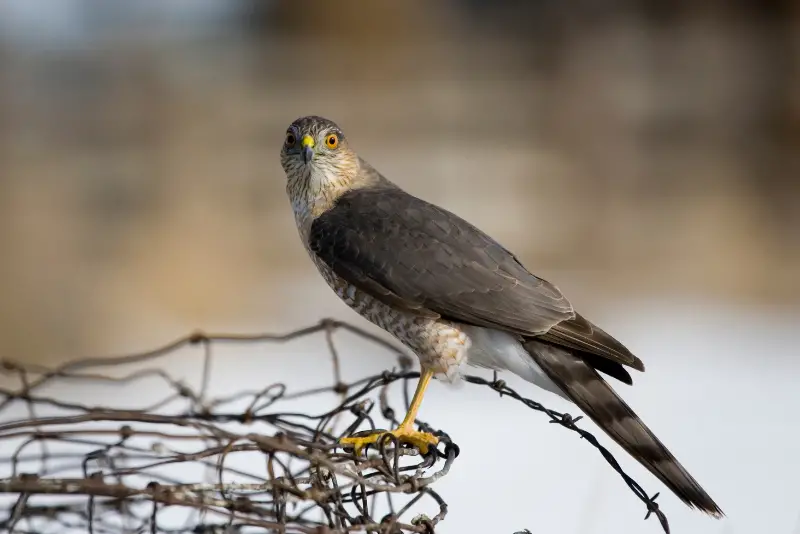
From the largest to the smallest hawk on the list, the sharp-shinned hawk is most commonly seen stalking song birds, making them a regular sight in backyards in the state.
With blue-gray wings and back, and with orange feather patterns on their chests, these hawks are recognizable by their small size, agility, and long tail.
Sharp-Shinned Hawks are common breeding birds throughout Illinois, and during winter they are joined by individuals that migrate south from Canada.
Cooper’s Hawk
Scientific name: Accipiter cooperii
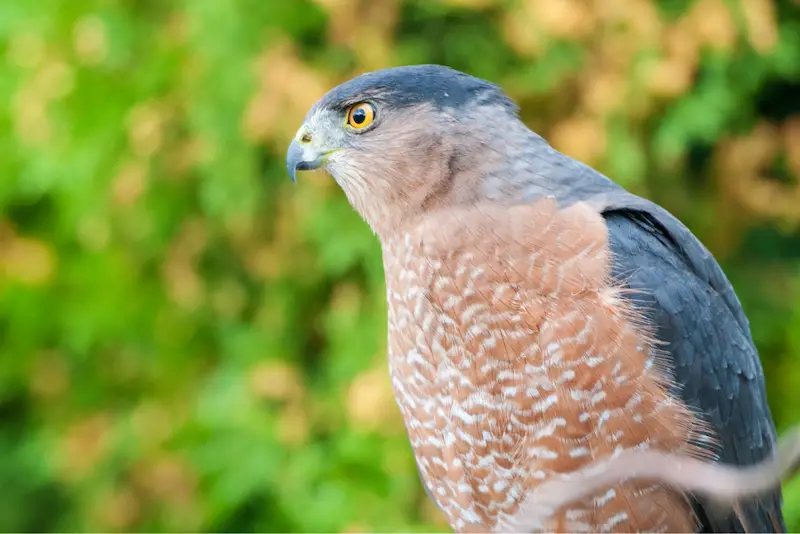
This little Illinois hawk is agile and skillful when it comes to catching small birds in flight. Sometimes it will even take species that are larger than itself.
Male Cooper’s Hawks have reddish-orange bars on their underside, while their upperparts are grayish-blue. The piercing eyes are vermillion red.
You’re most likely to notice the orange coloration on the chest and underside of a Cooper’s Hawk if you can observe it perched on a branch.
The long banded tail and small, rounded wings of the Cooper’s Hawk make it possible for this bird of prey to perform sharp turns and quick maneuvers in the thick foliage of dense forests and shrubs.
While Cooper’s Hawks were originally shy woodland raptors, they are now commonly found in urban areas such as Cleveland and Cincinnati, where they hunt doves and songbirds.
It is not unusual for a Cooper’s Hawk to show up around bird feeders, where it tries to surprise and ambush feeding songbirds with a lightning fast dash from a hidden perch.
It is a summer visitor in the northern parts of Illinois, but it can be found year-round in southern Illinois.
Northern Goshawk
Scientific name: Accipiter gentilis
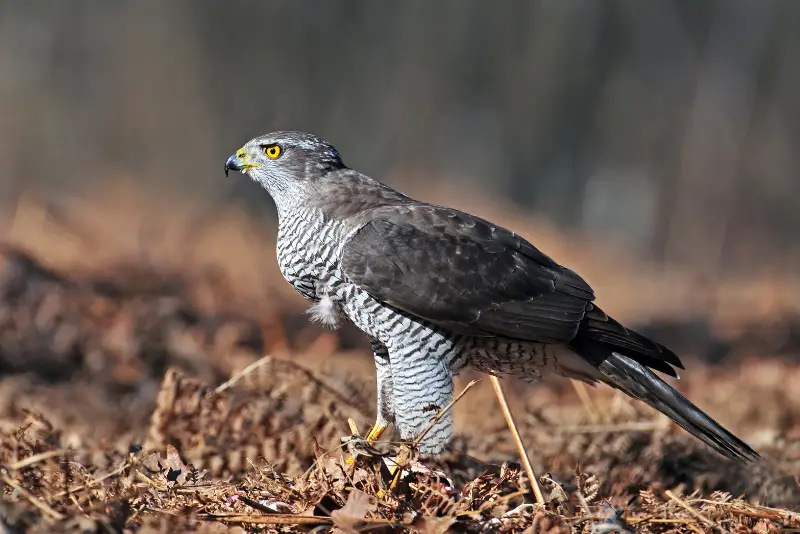
The Northern Goshawk is the largest accipiter hawk in the state of Illinois, and significantly larger than the Coopers’ and Sharp-shinned Hawks.
It also has slightly longer wings and a more rounded tail, and as a result looks slightly similar to buteo hawks.
However, its behavior is very different from buteo hawks, as it spends much less time soaring or perched in prominent locations.
Instead, the Northern Goshawk hunts by flying at low altitude over open woodland or along forest edges, in order to surprise its prey out in the open.
When this hawk does hunt from a perch, it is usually well hidden, and thus hard to spot.
Northern Goshawks are regular winter visitors in the northern parts of Illinois, and also occur as scarce visitors in the rest of the state at this time of the year.
Rough-legged Hawk
Scientific name: Buteo lagopus
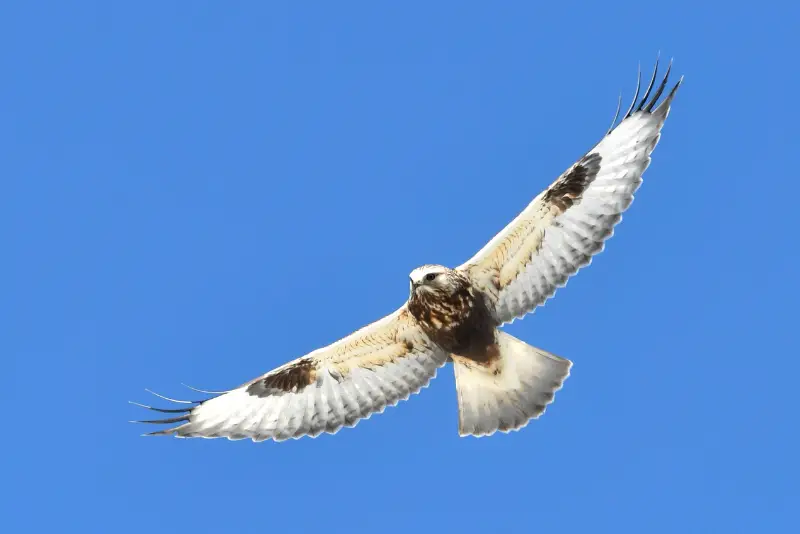
Rough-legged Hawks breed in the arctic tundra in northern Canada and Alaska, but can be seen wintering in large parts of the USA during the cold months.
The Rough-legged Hawk occurs in Illinois as a winter visitor from October through March, and favors open habitats such as farmland, pastures and marshland.
Its preferred foraging tactic is to hunt from a perch, such as a fence post or telephone pole, though it also hovers on occasion, similar to a kestrel.
This is a large buteo hawk (which is also called Rough-legged Buzzard), and is best identified by its dark brown belly, which contrasts with the white underside of its wings and tail.
Red-shouldered Hawk
Scientific name: Buteo lineatus
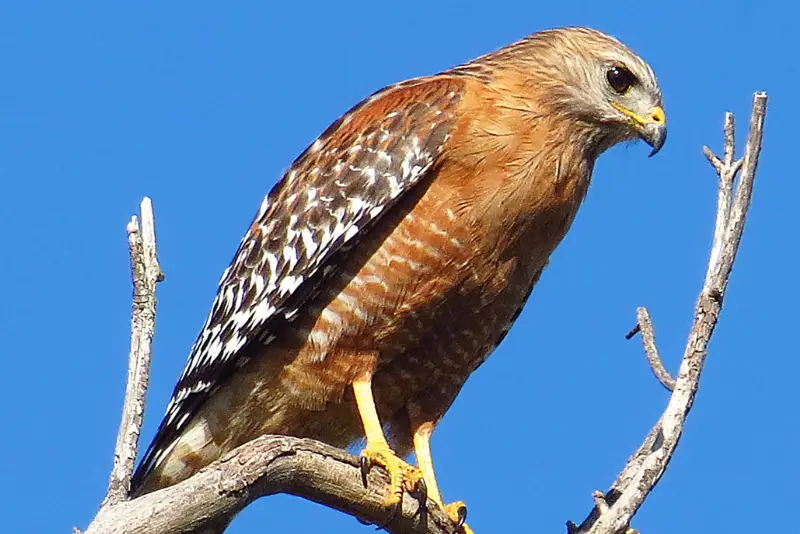
The Red-shouldered Hawk has two distinct populations – one in the eastern US, and another in California and Mexico.
The two populations are separated by more than 1000 miles, and thus rarely mix.
In Illinois the Red-shouldered Hawk is found in lowland forests throughout the state. It favors mature woods interspersed with water.
While more northern populations of the Red-shouldered Hawks are migratory, the Illinois population of these raptors is non-migratory.
In fact, adult hawks stay in their nesting territories all year round in Illinois.
Broad-winged Hawk
Scientific name: Buteo platypterus
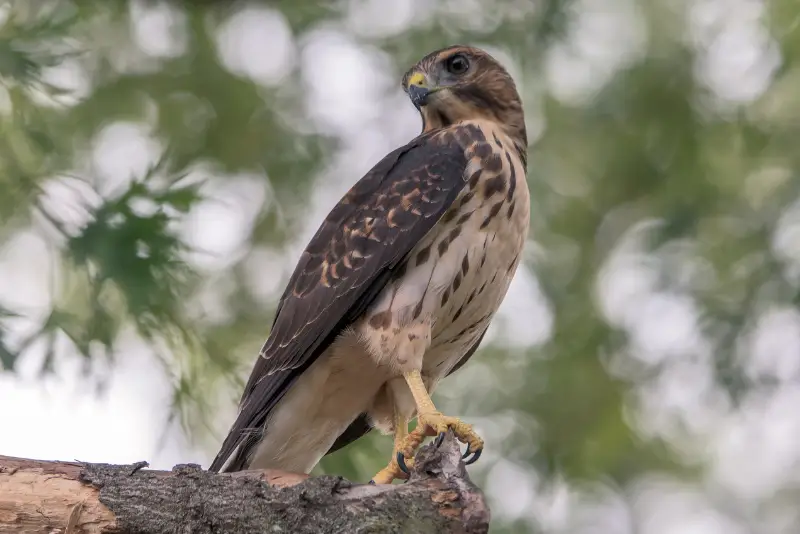
The Broad-winged Hawk is a long distance migratory species that spends the winter in South America.
During fall migration, it’s not uncommon to see flocks (also known as “kettles”) of Broad-winged Hawks soaring together to take advantage of thermal currents on their way south.
The Broad-winged Hawk is a common breeding bird throughout Illinois.
The preferred habitats of these medium-sized birds are extended forests, where the best way to detect them is by listening to their whistling call.
Harriers
Northern Harrier
Scientific name: Circus hudsonius
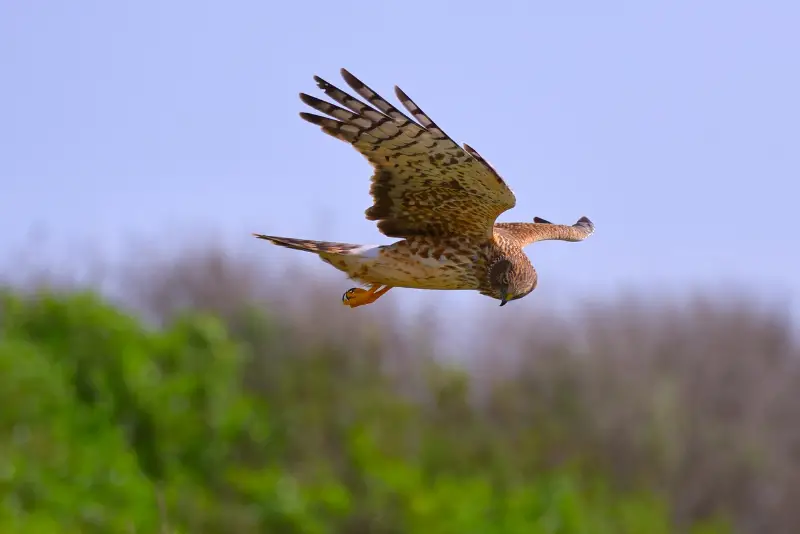
Northern Harriers breed in the northern parts of North America, but spend the winter in more southern parts of the USA, as well as Central America.
The Northern Harrier is a rare breeding bird in northern Illinois from May through September, and frequents open grassland and marshes as its habitat of choice.
During winter, its numbers increase due to harriers from Canada migrating to Illinois to spend the winter, and these birds can be encountered throughout the state.
Harriers are easily identified by their behavior. Their foraging tactic is to fly slowly close to the ground, in order to pounce on any rodent caught in the open outside its burrow.
Eagles
Bald Eagle
Scientific name: Haliaeetus leucocephalus
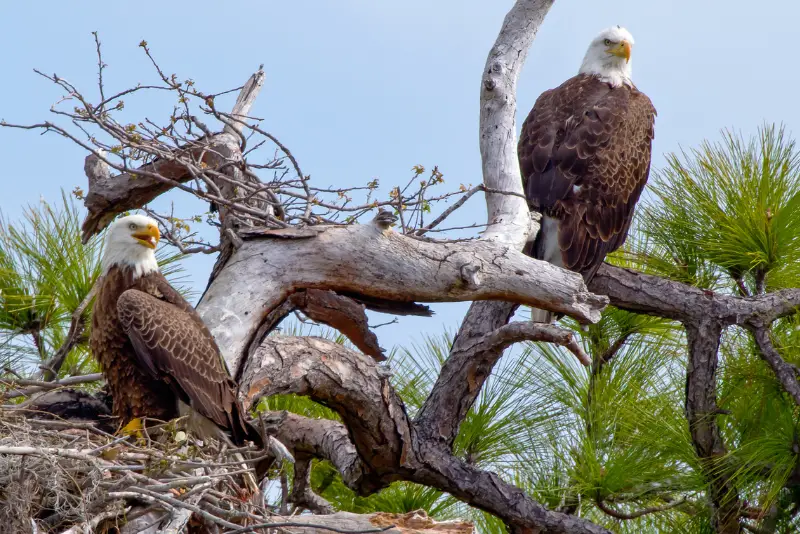
With a wingspan of up to 8 feet, the Bald Eagle is a huge raptor, and impossible to miss if you spot it soaring in the Prairie State.
Apart from its size, it is also one of the most easily recognizable birds in Illinois, due to its white head and tail, which contrast sharply with the uniformly dark brown body.
Juvenile birds are dark brown all over, with light irregular streaks all over the body, as well as a buff white belly.
This huge bird of prey is a breeding bird in northern Illinois, and is also found in other parts of the state outside of the breeding season.
During summer, the Illinois Bald Eagle population consists of about 40 pairs, but it grows dramatically to over 3,000 Bald Eagles wintering in Illinois during the cold months.
This influx of eagles during the cold season is due to the fact that the Prairie state is an important wintering ground for eagles breeding in Canada.
Bald Eagles spend a lot of their time soaring on thermal currents with their wings held flat. They feed on fish, birds, and small mammals, although a big part of their diet consists of carrion.
Golden Eagle
Scientific name: Aquila chrysaetos
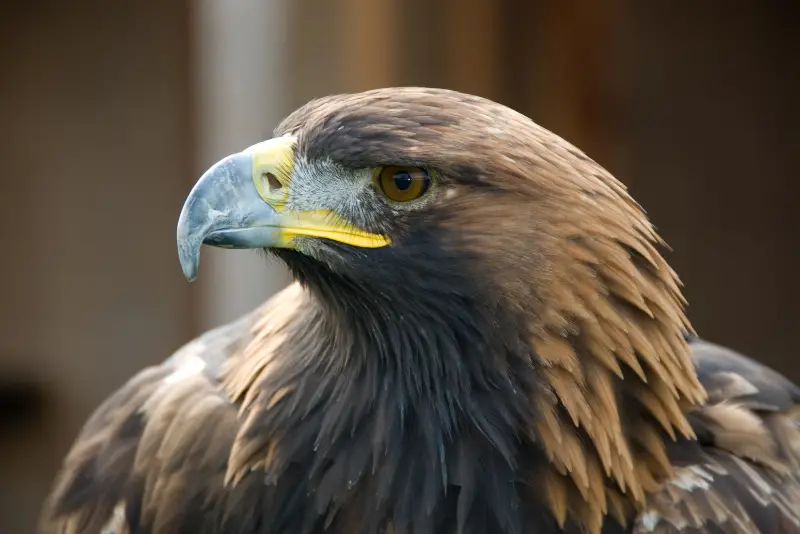
The Golden Eagle is one the most impressive eagle species in North America, and is a breeding bird in the western states of the USA.
In Illinois state, the Golden Eagle is a rare visitor that can be seen during spring or fall migration.
Golden Eagles can be distinguished from Bald Eagles by their lack of white coloration on their heads.
The Golden Eagle is one of several circumglobal raptor species, and can be found in both the New World and the Old World.
Osprey
Scientific name: Pandion haliaetus
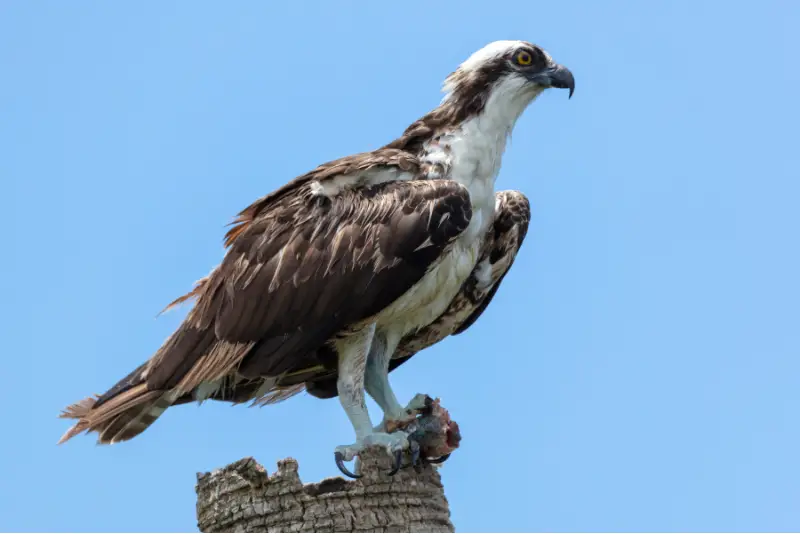
While the Osprey is technically not an eagle, it has a wingspan of up to 69 in (5.5 ft), and resembles an eagle in size.
It is usually easy to identify the Osprey due white belly and chest, which contrast with its blackish gray upperparts and black wrist patches on its lower wings.
This large Illinois bird is the only bird of prey species that plunges into water in order to catch fish, often becoming entirely submerged as it attempts to grab a fish with its feet.
Due to their style of hunting, Ospreys are almost always found close to a body of water, except during migration, when they will cross areas without water.
The Osprey is a regular breeding bird in Illinois,where it can be seen from April through late September. It is most common along the shores of Lake Michigan in northeastern Illinois.
Falcons
American Kestrel
Scientific name: Falco sparverius
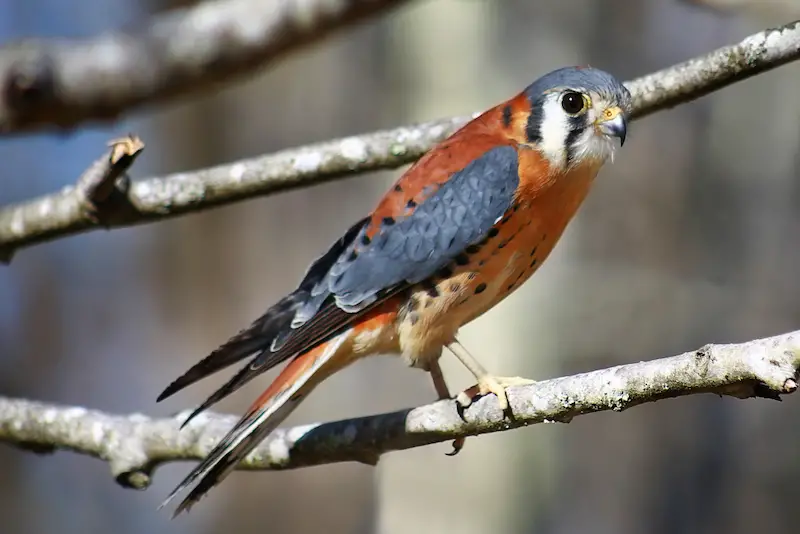
The American Kestrel is not only the smallest falcon in North America, but also one of the most common raptors.
Male American Kestrels are very colorful, and sport rufous orange upperparts and and tail, as well as blue gray wings with dark pointed tips.
The male also has a reddish orange cap on its crown, as well as a dark mustache and dark bar behind the eye.
Female American Kestrels are more pale in their coloration, but also have rufous orange upperparts.
When foraging for food, it likes to hover over open fields and meadows, or to hunt small animals from a perch such as a telephone pole or tree branch.
After it spots a rodent or other small animal, the American Kestrel dives down to grab it with its talons.
The most commonly taken prey during the spring and summer months are insects and worms, while rodents and small birds predominate during the colder months.
It likes to nest in abandoned Woodpecker holes, as well as crevices in buildings. Also accepts nesting boxes installed by humans.
The American Kestrel is a migratory raptor in the northern parts of its range, while it is a year-round resident in more southern parts. In Illinois, it is a summer visitor.
Peregrine Falcon
Scientific name: Falco peregrinus
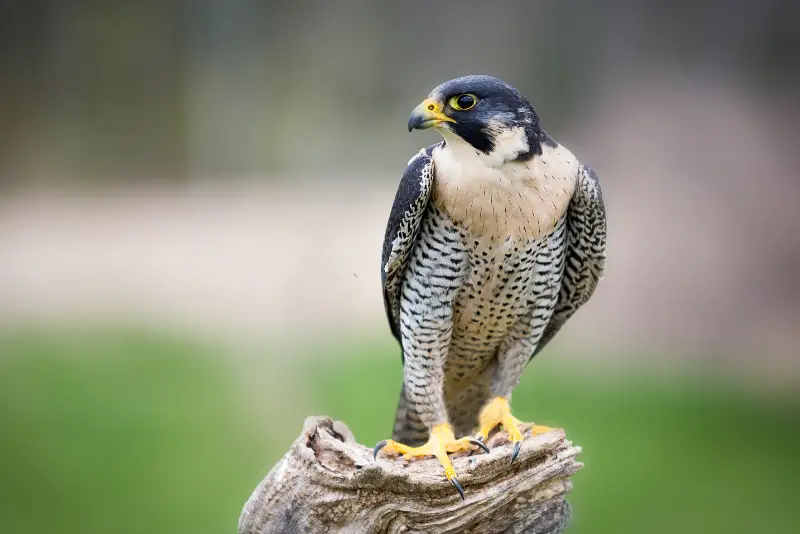
The Peregrine Falcon is the fastest animal in the world. Unbelievably, this falcon can dive from the sky at speeds reaching more than 200 mph.
This makes it perhaps the most accomplished Illinois bird of prey on this list. However, unlike other raptors, Peregrine Falcons feed almost exclusively on birds.
This dietary preference made them highly susceptible to the eggshell-thinning effects of the pesticide DDT, leading to a catastrophic population decline of peregrines in the 1960s and 70s.
But since DDT was made illegal, the Peregrine Falcon population has recovered from its previous decline, and this beautiful raptor is once again a regular sight in Illinois, especially in the northeastern parts.
Vultures
Turkey Vulture
Scientific name: Cathartes aura
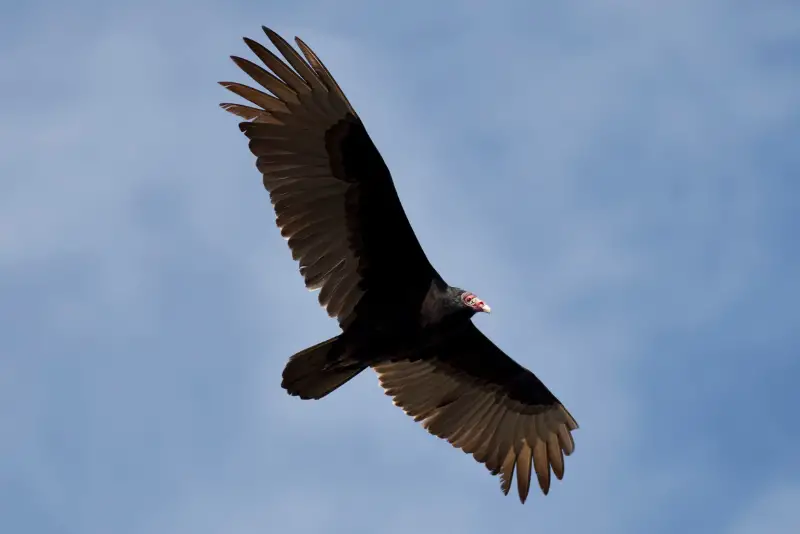
The Turkey Vulture is the largest vulture species that lives in Illinois, and can reach a wingspan of up to 6 feet.
It is a big black raptor with a red-colored head, and dark gray rear margins on their wings, which can be seen in flight.
A soaring Turkey Vulture is easily identifiable due to the fact that it holds its wings in an upright V shape, and has light wingtips.
This big raptor is a summer visitor and breeding bird in Illinois, where it favors open country interspersed with woodland.
Similar to other vulture species, this raptor is specialized in feeding on carrion, and will often congregate in flocks around roadkill.
While Turkey Vultures look superficially similar to Black Vultures, the latter are only rarely observed in Illinois.
Black Vulture
Scientific name: Coragyps atratus
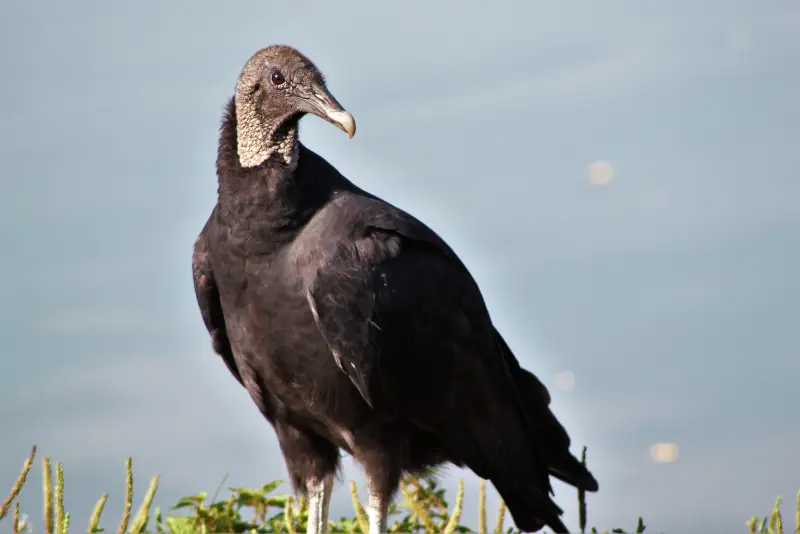
Black Vultures are common in southern and southeastern states. They occur as breeding birds in southern Illinois, where they can be seen year round.
Black Vultures are almost entirely black, except for white wing tips that can be seen from below. They have a naked head with wrinkled, dark skin.
Black Vultures that show up in Illinois are usually immature birds, as adult pairs remain in their breeding territories year-round.
In contrast to Turkey Vultures, Black Vultures don’t have a keen sense of smell. Because of this, they often use Turkey Vultures as “scouts” to find roadkill, and then intimidate the smaller vulture species to chase away from the carrion.
Related: What are the types of black birds in Illinois?
Owls
Great Horned Owl
Scientific name: Bubo virginianus
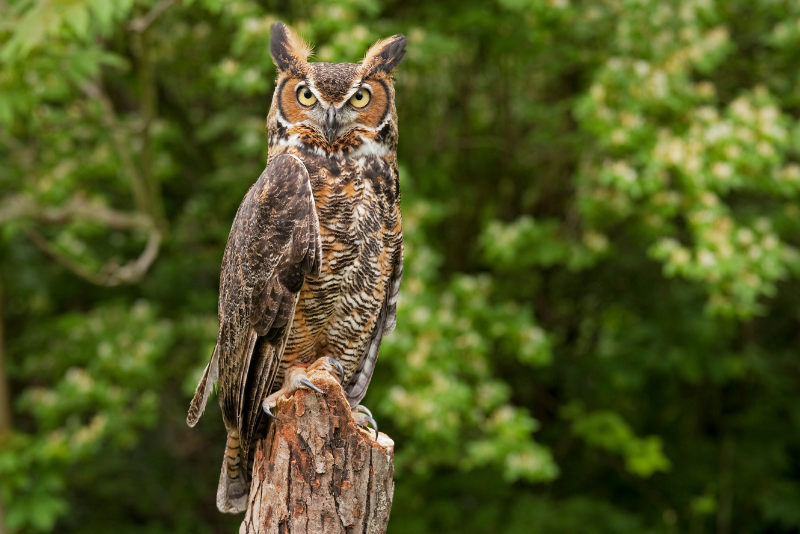
With a wingspan up to 4 feet, the Great Horned Owl is the largest owl species breeding in Illinois.
It is a large brown-colored bird with two ear tufts (also called horns) and big yellow eyes.
In Illinois, this owl starts its nesting very early in the year, laying its eggs in January or February.
It is almost entirely nocturnal, and can hunt in complete darkness by relying on its keen sense of hearing.
The Great Horned Owl doesn’t build its own nest, but instead occupies the nests of other large birds, such as Illinois herons or raptors.
It can be seen in Illinois year-round, and can be found in a wide variety of habitats, from woodlands to suburban areas.
This owl is a fierce hunter, catching birds up to the size of ducks, and mammals up to the size of squirrels, rabbits, and even young foxes.
Barn Owl
Scientific name: Tyto alba
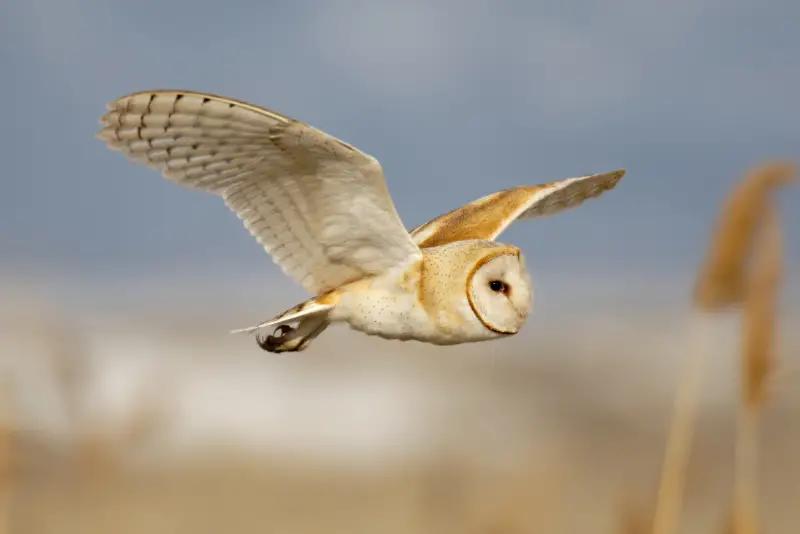
Somewhat softer and less intense-looking than the Great Horned Owl, Barn Owls are characterized by their white coat of feathers, and their “friendlier” appearance.
Armed with exceptional night vision, Barn Owls are strictly nocturnal raptors and therefore hard to spot. However, they can be readily identified by their characteristic screeching calls.
And if you do spot one flying overhead by the light of the moon, you may be able to see the glow of their white underside.
These common Illinois owls are present in the state all year round, and favor open areas and farmland as their hunting grounds.
Long-eared Owl
Scientific name: Asio otus
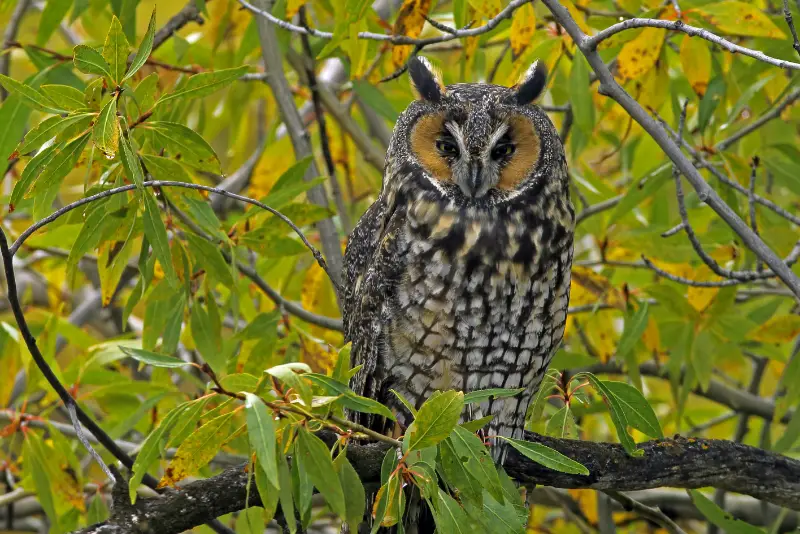
These well-camouflaged, elusive owls are smaller than the aforementioned species, and only occur in Illinois as winter visitors from October through March.
They use their favored habitat of dense wooded areas to prey on the small rodents and animals that call the nearby grasslands their home.
Similar to other owl species, Long-eared Owls can fly completely silently due to fringes on their flight feathers.
Together with their keen sense of hearing, this enables them to catch prey by surprising it in the dark of the night.
But despite their best efforts to remain hidden, these owls can be identified by their long, low hoots.
Another great characteristic for identifying these owls is by their elongated tufts of feathers on the ears, and their droppings found underneath conifer trees close to grassy areas.
Short-eared Owl
Scientific name: Asio flammeus
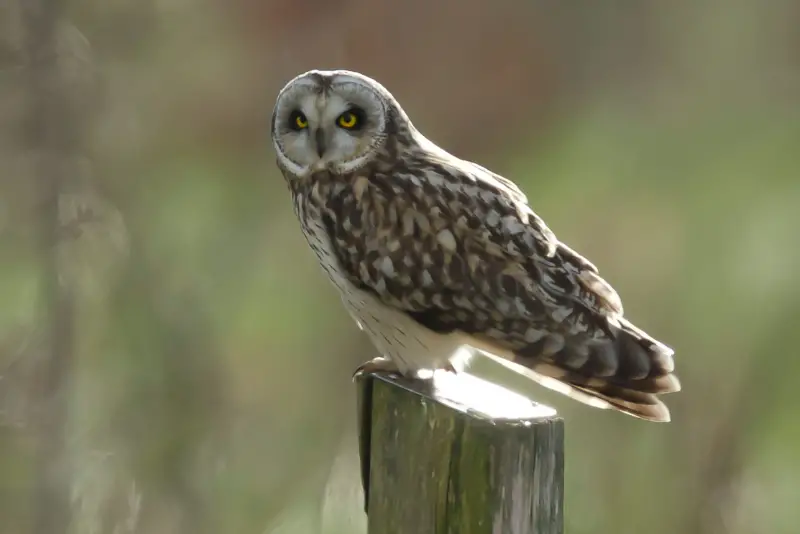
The Short-eared Owl is a highly migratory owl species that breeds in Illinois, but spends the winter in southern states.
Short-eared Owls are more often observed hunting in daylight than other owls species.
Together with their hunting tactic of flying low over the ground in open areas, this makes them relatively easy to spot.
You can encounter these owls in Illinois in any kind of open landscapes, including farmland, airports, and fallow land.
Barred Owl
Scientific name: Strix varia
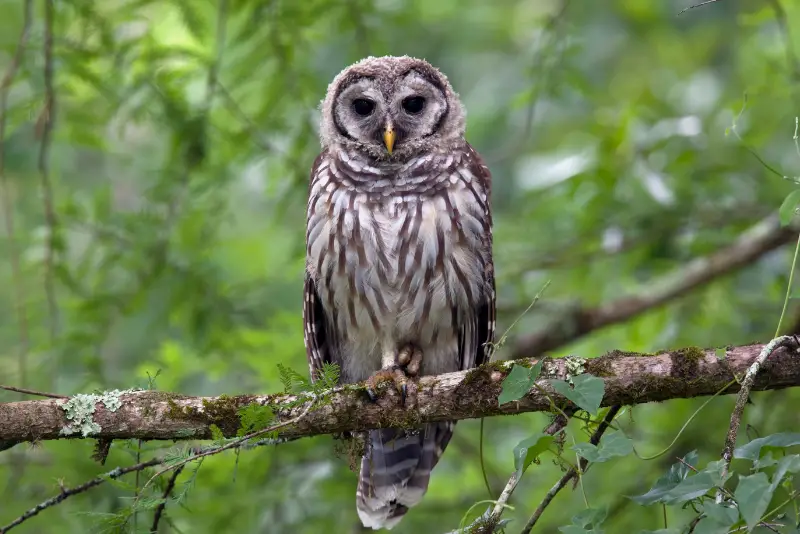
The Barred Owl was originally a bird of eastern North America, but it steadily expanded its range westwards over the past century.
This owl now has breeding populations in the Pacific Northwest. In Illinois, it can be encountered throughout the state where there are suitable habitats.
Similar to other owls, the Barred Owl is easiest to find by listening for its characteristic hooting call.
Their preferred habitat is mature forest and forests bordering swamps. They readily accept nest boxes that are set up in old trees.
Snowy Owl
Scientific name: Bubo scandiacus
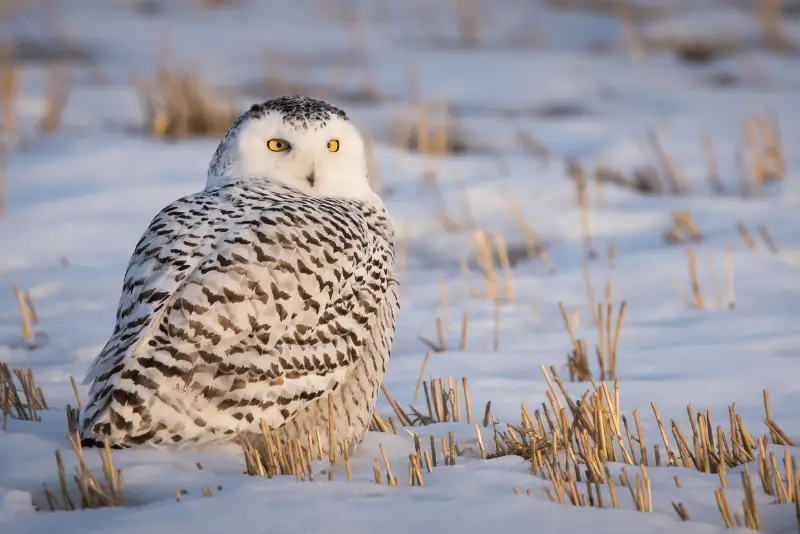
The Snowy Owl is the largest owl species in North America, and weighs more than the Great Horned Owl.
Snowy Owls are rare winter visitors in Illinois, where they can be seen in wide open areas, such as shorelines and grassland.
These owls breed in the high arctic (far north of the arctic circle), where they hunt ptarmigans and lemmings.
Snowy Owls are easily recognizable by their large size, rounded head white coloration with varying amounts of black markings.
These big birds favor open ground, and can often be observed perching on the ground. In cultivated landscapes they also perch on hay bales, fence posts and telephone poles.
Snowy Owls follow the population changes of small rodents, and are most common in winters with high rodent populations.
Eastern Screech-Owl
Scientific name: Megascops asio
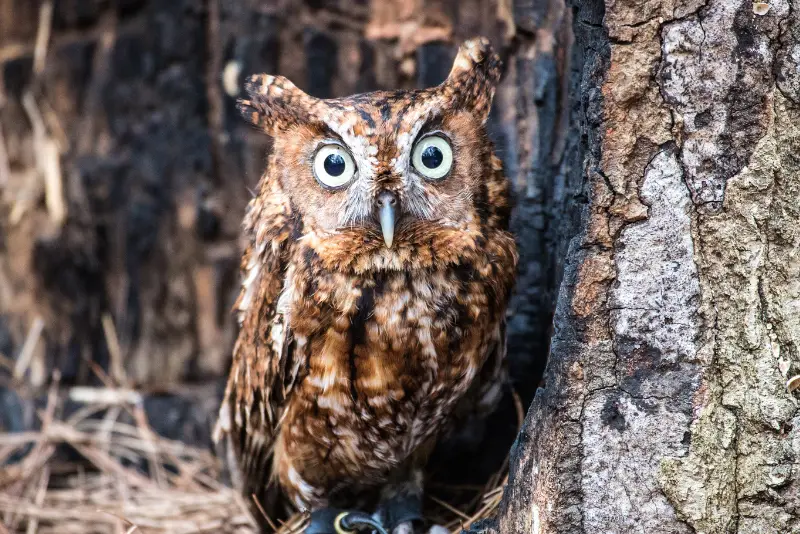
Originally birds of open woodlands, Eastern Screech-Owls have adapted very well to urban habitats, and are regularly found in parks, large gardens, and golf courses.
They breed in tree cavities, and are best identified by their characteristic series of accelerating hoots.
These owls are common throughout Illinois where they can be seen all year round.
They have a very varied diet, which includes any type of small animal ranging from worms to insects, rodents, and reptiles.
Eastern Screech-Owls readily accept artificial nesting cavities, which means you can attract them to your backyard by setting up nest boxes.
Northern Saw-whet Owl
Scientific name: Aegolius acadicus
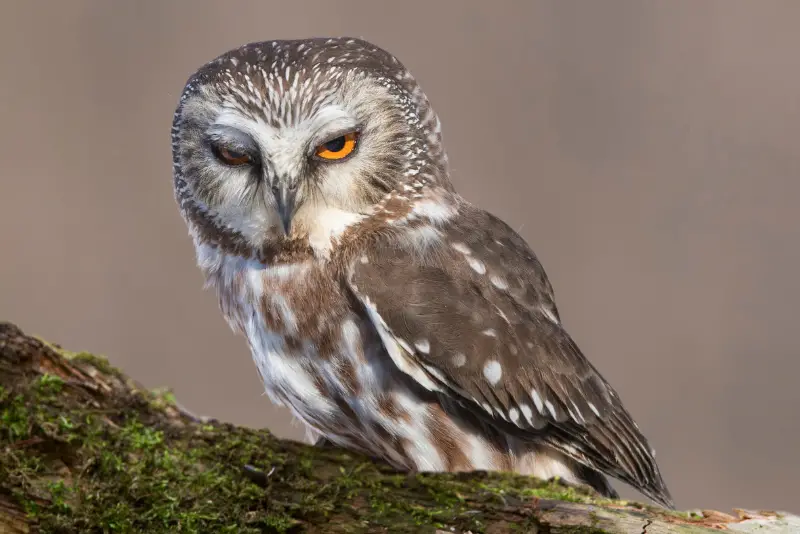
This is another small owl species that’s hardly larger than a pint. The Northern Saw-whet Owl is one of the most common owls in Illinois.
These owls are hard to see, but they are easy to detect if you listen for their characteristic too-too-too call at night.
They build their nest in tree cavities, but also readily accept man made nest boxes. So if you have a large garden with mature trees, it’s worth putting up a nest box well before the nesting season.
Conclusion
And there we have the most common raptors in Illinois.
The varied habitats of Illinois are home to more than 400 different species of birds, and birds of prey make up a significant proportion of this rich avifauna.
Ranging from hawks to eagles, vultures, falcons, and owls, these birds of prey play a vital role as apex predators.
Raptors are paramount to maintaining balanced rodent and small wildlife populations, as well as helping to dispose of animal carcasses with scavenging.
If you enjoyed this article, check out our guide to the yellow birds in Illinois.
